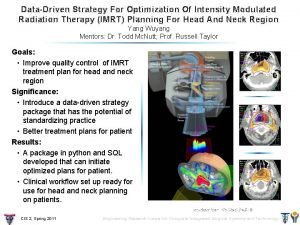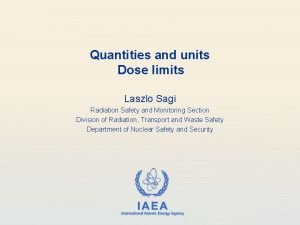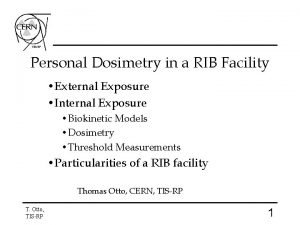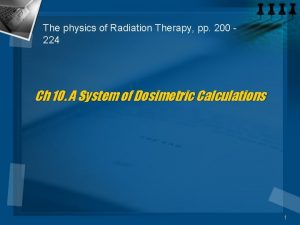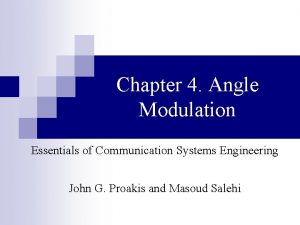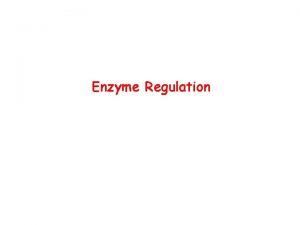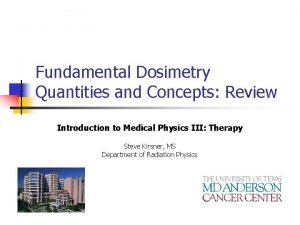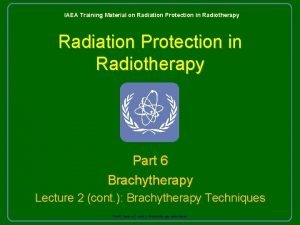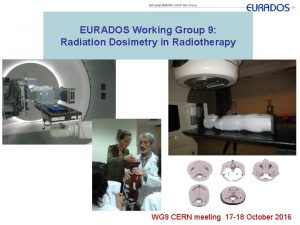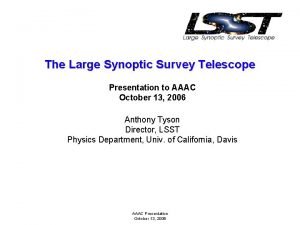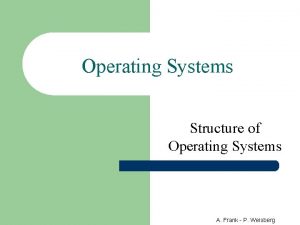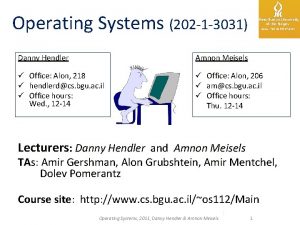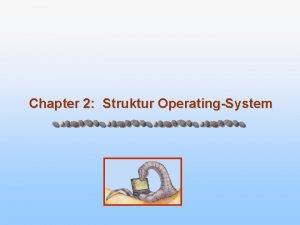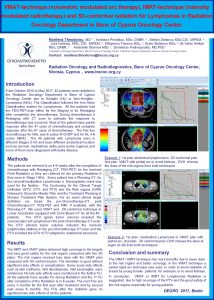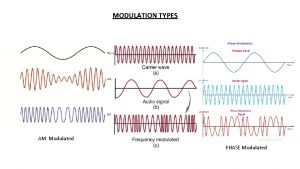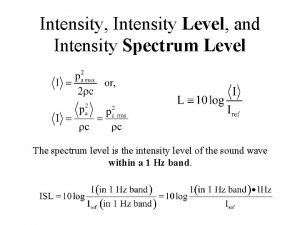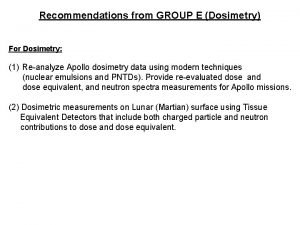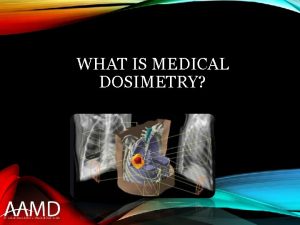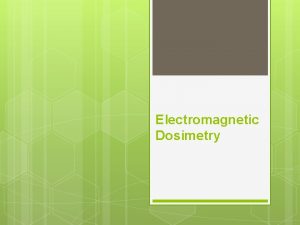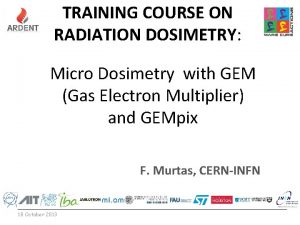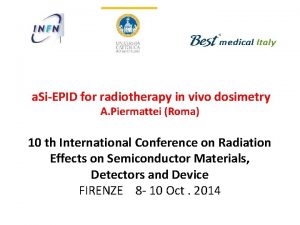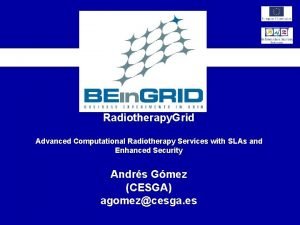Dosimetry and Verification of Intensity Modulated Radiotherapy Monolithic















- Slides: 15

Dosimetry and Verification of Intensity Modulated Radiotherapy: Monolithic Active Pixel Sensors Dr. Lana Beck, Dr. Richard Hugtenburg, Dr. Chiara de Sio, Dr. Jaap Velthuis

Outline Intensity Modulated Radiotherapy (IMRT) Treatment Verification Monolithic Active Pixel Sensors Leaf position reconstruction Radiation Hardness Dosimetry with MAPS Current status Summary 2

Intensity Modulated Radiotherapy In IMRT X-rays from a LINAC typically using multi-leaf collimators (MLC) to form complex beam shapes of varying intensity Unlike conventional and 3 D-conformal radiotherapy, standard methods of invivo dosimetry don’t work as the beam portal shape is no longer well defined Dosimetry methods have been developed that use either pretreatment or a real-time verification 3

Treatment verification There remains a need for Radiation Offers New Cures, and independent verification of RT treatments – which is now mandated Ways to Do Harm – NY Times in many parts of the world Online dosimetry provides verification without pre-treatment measurements • Enhances safety • Relaxes demand on the accelerator Online systems measure two things: - The collimator positions - The photon fluence profile 4

Online Verification of IMRT treatments Can be done in two ways: • Upstream, i. e. transmission dosimetry • Downstream i. e. EPID dosimetry is difficult due to non-uniform and varying interactions in the patient Transmission dosimetry systems need to be thin to reduce scattering and attenuation of the beam The challenge with the latter is then the separation of the photon fluence from other beam components/ contaminants 5

Electron-photon separation The beam consists of therapeutic photons and contaminant electrons/ positrons γ e- Current up-stream detector systems use a thick layer to convert photons into the charge particles that are detected The number of photons detected needs to significantly outnumber the contaminant particles A converter increases the thickness of the device and disturbs the beam 6

Monolithic Active Pixel Sensors MAPS are ideal for upstream monitoring: Thin, have small pixels, and are fast and cheap Signal generation is in a thin epitaxial layer (<20μm) Bulk is for mechanical support: 30 μm thick detectors are easily constructed < 0. 1 % attenuation for 6 MV photons Each pixel has in-pixel amplification with high S/N and a fast readout process 7

Prototypes • • • Achilles (STFC developed) 6 x 6 cm sensor 14 μm thick epitaxial layer 3 T pixel architecture with 14 μm pitch • • LASSENA 12× 14. 5 cm sensor 3 -side buttable: allows 2×N tiling 50 μm pitch 32 analogue outputs operating at 10 Mpixel/sec = 34 fps 8

MLC leaf-finding Exceptional precision is obtained. 52 ± 4 μm in a single frame MLC and Jaws 4096 x 4096 acquisition 1024 x 1024 Gaussian smoothing with a 15 pixel radius kernel 9

Video demonstration of leaf edge finding 10

Dosimetry with a MAPS A conversion layer is used to convert photons into electrons We have shown that acceptable accuracy can be achieved for small fields with a thin layer of plastic achieving 5% precision and 1% attenuation Better precision can be achieved with a more adventurous converter designs. 11

Dosimetry with a MAPS There are four signal generating processes Modulate of process 4 can be achieved by changing the amount of material upstream of the sensitive layer A modulation pattern can be etched in the silicon bulk on the under-side of the detector 12

Radiation damage Fractions are typically 3 Gy One machine delivers ~10, 000 treatments per year Only 10% of the dose is absorbed in the panel, so around 3 k. Gy per annum Sensor was damaged with a variety of doses of protons ranging from 1 -50 k. Gy [needed to achieve this dose range, representing a worst-case scenario After 50 k. Gy no significant signs of degradation to logic and leaf finding Will survive long term clinical operation. 13

Current status A patent for transmission dosimetry using MAPS has been granted in the US and Europe Have recently applied for second patent for dosimetry Working with 2 industrial partners to get the device on the market. Currently building a full-size prototype. Team received STFC IPS funding until 31/10/2020 - Will focus on testing sensor with higher dynamic range - Optimization of the converter layer The system could monitor the health of the accelerator and collimator systems and through collection at a central data-point assist in machine learning to improve accelerator performance and up-time. 14

Summary We have developed a real-time, thin, upstream beam profile and dose verification device • Patent granted in US and Europe • Excellent leaf position resolution. • Dosimetry is achieved in a thin form-factor using a silicon converter grating • Currently building a full size prototype. The device can verify treatment in real-time WITHOUT need for prior measurements • Enhances safety • Relaxes demands on the accelerator 15
 Intensity modulated radiation therapy
Intensity modulated radiation therapy Internal dosimetry
Internal dosimetry Internal dosimetry
Internal dosimetry Ssd and sad technique in radiotherapy
Ssd and sad technique in radiotherapy Spectral characteristics of angle modulated signals
Spectral characteristics of angle modulated signals Regulation of enzyme quantity
Regulation of enzyme quantity Bsf
Bsf Radiotherapy
Radiotherapy Pterigiums
Pterigiums Radiotherapy
Radiotherapy Siemens radiotherapy
Siemens radiotherapy Monolithic telescope
Monolithic telescope Monolithic trench drains
Monolithic trench drains Monolithic operating system
Monolithic operating system Monolithic structure in os
Monolithic structure in os Monolithic structure in os
Monolithic structure in os
